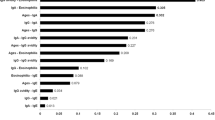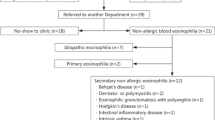Abstract
Toxocariasis is one of the causes of eosinophilia in peripheral blood and provokes eosinophilic infiltration in internal organs. Extended studies on the prevalence and clinical characteristics of toxocariasis have been rare. The aim of this study is to evaluate the prevalence of toxocariasis in unknown eosinophilia and to analyze the efficacy of toxocara enzyme-linked immunosorbent assay (ELISA). We evaluated patients presenting with peripheral blood eosinophilia (>500 cells/μl or ≥10% of white blood cell count). After checking drug histories and the presence of allergic diseases and parasitic infections, specific serum IgG antibody to Toxocara canis larval antigen was measured by ELISA. Liver and lung involvement was also evaluated. One-hundred and three patients were evaluated, and the mean age was 50.9 years old. Seventy patients (68.0%) were diagnosed as having toxocariasis. The patients who had a history of raw liver eating had a higher incidence, and the patients with liver involvement had higher serum eosinophil cationic protein values. The eosinophil count was normalized in 7 of 16 treated patients and in 25 of 54 untreated patients. The mean improvement duration was 12 months. We concluded that the prevalence of toxocariasis was high in patients with unknown eosinophilia, and the toxocara ELISA was essential for evaluation of the causes of unknown eosinophilia.

Similar content being viewed by others
References
Arias Irigoyen J, Senent Sanchez CJ (1995) Toxocariasis: a cause of hyper IgE and eosinophilia. J Investig Allergol Clin Immunol 5:232–234
Buijs J, Borsboom G, Renting M, Hilgersom WJ, van Wieringen JC, Jansen G et al (1997) Relationship between allergic manifestations and Toxocara seropositivity: a cross-sectional study among elementary school children. Eur Respir J 10:1467–1475
Choi JH, SuhYJ, Jung JW, Song HJ, Suh CH, Hug S et al (2003) Clinical significance of serum ECP and sero-prevalence of human toxocariasis in patients with eosinophilia. J Asthma Allergy Clin Immunol 23:26–32
Despommier D (2003) Toxocariasis: clinical aspects, epidemiology, medical ecology, and molecular aspects. Clin Microbiol Rev 16:265–272
Glickman LT, Cypess RH (1977) Toxocara infection in animal hospital employees. Am J Public Health 67:1193–1195
Jacquier P, Gottstein B, Stingelin Y, Eckert J (1991) Immunodiagnosis of toxocarosis in humans: evaluation of a new enzyme-linked immunosorbent assay kit. J Clin Microbiol 29:1831–1835
Jang JK, Paik SW, Choi MS, Lee JH, Koh KC, Chae GS et al (2001) Clinical characteristics of 19 cases of biopsy-proven eosinophilic liver abscess: single center experience. Korean J Gastroenterol 38:37–41
Johkoh T, Muller NL, Akira M, Ichikado K, Suga M, Ando M et al (2002) Eosinophilic lung diseases: diagnostic accuracy of thin-section CT in 111 patients. Radiology 216:773–780
Kita H, Gleich GJ, Adolphson C (2003) Biology of eosinophils. In: Adkinson NF, Yunginger J, Busse W, Bochner B, Holgate S, Simons FE (eds) Middleton’s allergy principles and practice, 6th edn. Mosby, Philadelphia, pp 305–332
Magnaval JF, Berry A, Fabre R, Morassin B (2001) Eosinophil cationic protein as a possible marker of active human Toxocara infection. Allergy 56:1096–1099
Morris PD, Katerndahl DA (1987) Human toxocariasis. Review with report of a probable case. Postgrad Med 81:263–267
Nash TE (2000) Visceral larva migrans and other unusual helminth infections. In: Mandell G, Bennett J, Dolin K (eds) Principles and practice of infectious disease, 5th edn. Churchill Livingstone, New York, pp 2965–2970
Obwaller A, Jensen-Jarolim E, Auer H, Huber A, Kraft D, Aspock H (1998) Toxocara infestations in humans: symptomatic course of toxocariasis correlates significantly with levels of IgE/anti-IgE immune complexes. Parasite Immunol 20:311–317
Pawlowski Z (2001) Toxocariasis in humans: clinical expression and treatment dilemma. J Helminthol 75:299–305
Rothenberg ME (1998) Eosinophilia. N Engl J Med 338:1592–1600
Shakib F, Pritchard DI, Walsh EA, Smith SJ, Powell-Richards A, Kumar S et al (1993) The detection of autoantibodies to IgE in plasma of individuals infected with hookworm (Necator americanus) and the demonstration of a predominant IgG1 anti-IgE autoantibody response. Parasite Immunol 15:47–53
Tefferi A (2005) Blood eosinophilia: a new paradigm in disease classification, diagnosis, and treatment. Mayo Clin Proc 80:75–83
van Assendelft OW (1985) Reference values for the total and differential leukocyte count. Blood Cells 11:77–96
Weller PF (2003) Eosinophilia and eosinophil-related disorders. In: Adkinson NF, Yunginger J, Busse W, Bochner B, Holgate S, Simons FE (eds) Middleton’s allergy principles and practice, 6th edn. Mosby, Philadelphia, pp 1105–1126
Author information
Authors and Affiliations
Corresponding author
Rights and permissions
About this article
Cite this article
Kwon, NH., Oh, MJ., Lee, SP. et al. The prevalence and diagnostic value of toxocariasis in unknown eosinophilia. Ann Hematol 85, 233–238 (2006). https://doi.org/10.1007/s00277-005-0069-x
Received:
Accepted:
Published:
Issue Date:
DOI: https://doi.org/10.1007/s00277-005-0069-x




